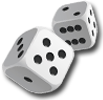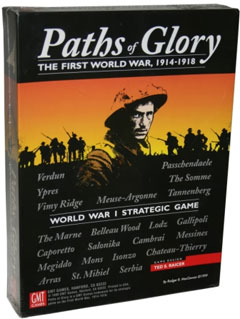



play board games
Board game reviews, strategy tips & session reports
Paths of Glory War Game Review
 Stats:
Stats:
No. of players: 2 (solo play is also possible)
Amount of time to play: 240-480 min (depending on scenario)
Age requirements: 14+
Set-up time: 15 min
Paths of Glory is a card-driven, medium weight war game for two players. The game takes place during WWI and you play either the Allied forces or their Central Powers opponents.
Paths of Glory Rules Description:
Paths of Glory has two separate decks one for each side. These decks consist of three sub-decks: Mobilization, Limited War and Total War. You begin the game with your Mobilization deck and add the others as you increase your war status with Events.
The game turn is divided into eight phases: Mandated Offensive, Action, Attrition, Siege, War Status, Replacement and Draw.
You roll a die each Mandated Offensive phase to determine if a nation must attack this turn. You will lose victory points if your nation doesn’t attack.
The Action phase consists of six rounds of card play. You alternate actions with your opponent and play one card. Each card may be played for one of four different effects: Events, Operations Points, Strategic Redeployment, Replacements or as Combat Modfiers. Used for Operations you may move and attack. Strategic Redeployment represents long distance movement. Replacements add units at the end of turn. While Combat Modifiers change your (or your opponent’s) DRM (die roll modifier).
If your units are out of supply they are removed during the Attrition phase. Your unit is determined to be out of supply if it doesn’t connect via friendly spaces to a supply source. Armies removed this way are lost from the game. Corps units lost to attrition return to the replacement area on the map.
During the Siege phase, your forts under siege must roll to resist or be destroyed. Destroys forts may not be replaced and no longer give advantages to your defending units.
You check your War Commitment Level in the War Status phase. If it is high enough you add the Limited War cards to your Mobilization deck and later add the Total War cards. You also check if either player has met their victory conditions. If the combined total of both players’ War Status is 40 or more the game ends and victory is determined.
You spend your replacement points are spent to heal damaged units or add new units to the game. The number of points you have to spend during each Replacement Phase is determined by the cards you played for Replacement during the Action phase.
Lastly you draw back up to seven cards discarding any unwanted combat cards before you draw.
Quick Review of Paths of Glory:
Paths of Glory is strategic, intense and fun. You will find yourself wanting to do more than you can on most every turn. The card play during the Action phase will determine whether you can beat your opponent.
Paths of Glory looks great and the components are top-notch. The rules are clearly written and annotated well. You will want to keep them close for the first few games. There are a lot of exceptions to the rules and you’ll need to reference them. Thankfully they are listed on a page in the back of the rulebook. I also think you should read the rules then read the example of play and then read the rules again. It will help you learn some basic strategies and the basics of the game.
Like I said the card play is the meat of Paths of Glory and since each card can be used for several different things you’ll need to determine the best uses for the cards you draw. If you play this game with someone with analysis paralysis you might want to split the session into two evenings. You might want to do that anyway as Paths of Glory is long.
I don’t like making game length a negative thing but for me it can be. You should be aware one full campaign game can take about 10 hours. I have a family and know the game length will be a barrier to get this on the table. That may be different for you but just be aware, it is a long game.
I am not a huge war gamer but think most everyone should try Paths of Glory out. War gamers will love it and most everyone should enjoy it.
Score and synopsis: (Click here for an explanation of these review categories.)
Strategy 4 out of 6
Luck 4 out of 6
Player Interaction 5 out of 6
Replay Value 4 out of 6
Complexity 5 out of 6
Fun 5 out of 6
Overall 5 out of 6

Sounds cool!
I agree with your review. PoG is an excellent game. If you study WWI, you will find that the game mirrors the action in many ways. There are also expansion cards that add even more realism to the game. The CDG (Card Driven Game) format is perfect for this type of game that has a combination of political events and military action.
It is, as you noted, somewhat of a long game. We who are wargamers are accustomed to that and don’t consider it an obstacle. In our campaign play, it took us approximately 15 hours or more. We split it up into multiple days over several weeks.
I don’t think you will find a better strategic simulation of the First World War.
after you play it a few times the game will last about 6 hours. thats about the limit given in compitition at WBC